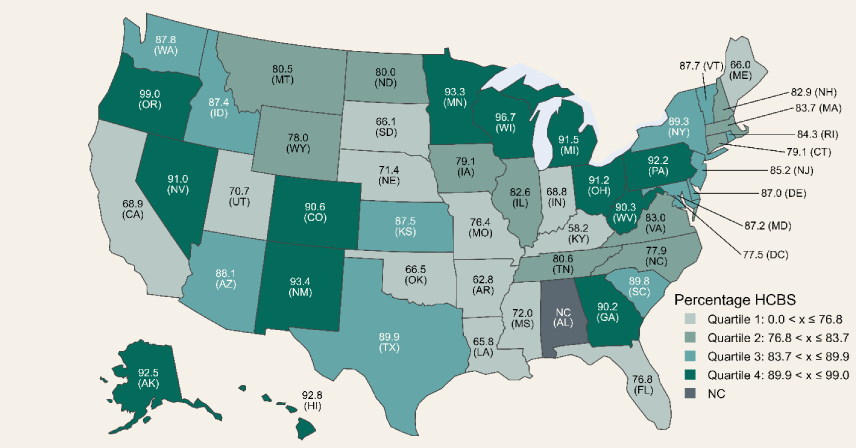The Centers for Medicare & Medicaid Services (CMS) has released three reports, showing major progress among states in rebalancing spending on Medicaid long-term services and supports (LTSS) toward home and community-based services (HCBS) and painting a clearer picture of LTSS users.
The three reports discuss LTSS rebalancing trends and patterns in users and spending for different types of HCBS and institutional care, nationally and across states, for 2019–2021.
States have long sought to rebalance their Medicaid LTSS systems by shifting expenditures away from services provided in institutional settings and toward HCBS as a response to the shift in demand and enrollee preference. CMS’s new reports show progress in these efforts, both in the share of Medicaid LTSS users receiving HCBS and the share of Medicaid LTSS spending devoted to HCBS. In 2021, 86.2 percent of LTSS users received HCBS, up from 84.5 percent in 2020, and 63.2 percent of LTSS expenditures went toward HCBS, up from 60.9 percent in 2020.
Mathematica and CMS improved the methods, outputs, and format of the reports to make the findings more accessible to the stakeholders who use them to track progress in rebalancing.
“As demand for LTSS continues to rise, giving states a better view of their expenditures and users is vital to ensuring all beneficiaries who use Medicaid LTSS receive the best care possible,” said Andrea Wysocki, senior researcher with Mathematica.
More highlights from the reports include:
- In 2021, most people using HCBS were younger than age 65, were not dually eligible for Medicare and Medicaid, lived in an urban area, and spoke English as their primary language.
- In 2021, most people using institutional services were older than age 65, were dually eligible for Medicaid and Medicare, lived in an urban area, and spoke English as their primary language.
- 7.5 million HCBS users accounted for $115.0 billion in HCBS spending in 2021. HCBS users and expenditures rose by 0.3 percent and 18.4 percent, respectively, from 2019 to 2021.
- A total of 1.5 million institutional service users accounted for $67.0 billion in institutional spending in 2021. Institutional users and expenditures fell by 18.0 percent and 7.2 percent, respectively, from 2019 to 2021.
Percentage of total LTSS users who use HCBS by state, 2021

Source: Mathematica’s analysis of the 2021 Transformed Medicaid Statistical Information System Analytic Files, Release 1.
Note: The LTSS user rebalancing ratio is the total unduplicated number of HCBS users as a percentage of the total unduplicated number of LTSS users. We rounded the state percentages to one decimal place in the figure, but we grouped states into quartiles based on the unrounded values. We did not calculate Alabama’s 2021 user rebalancing ratio due to concerns about data quality.
HCBS = home and community-based services; LTSS = long-term services and supports; NC = not calculated.
“The differences between institutional and HCBS users are important to keep in mind when designing policies for both users,” added Wysocki. “States with a higher percentage of institutional users might have access disparities that can be addressed through more HCBS funding. Mathematica is committed to helping CMS find the best ways to use these data and evidence to improve the lives of millions of enrollees.”
About Mathematica
Mathematica is a research and data analytics consultancy driven by a mission to improve well-being for people and communities. We innovate at the intersection of data science, social science, and technology to translate big questions into deep insights. Collaborating closely with decision makers and changemakers, we’re reimaging the way the world collects, analyzes, and applies data to solve urgent challenges.
Media Contact
-
Todd Kohlhepp
Mathematica, Public Affairs Specialist
tkohlhepp@mathematica-mpr.com
609-275-2200


